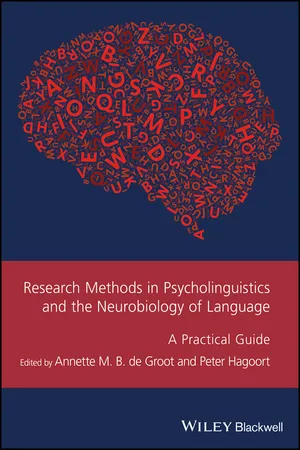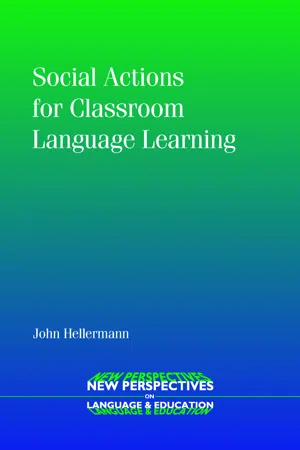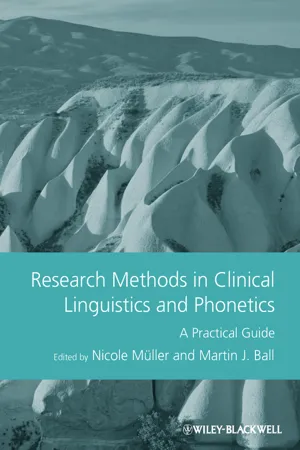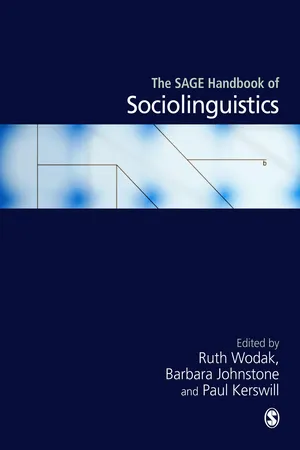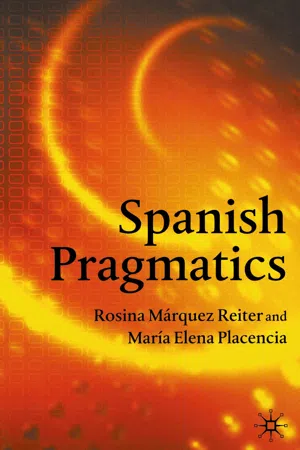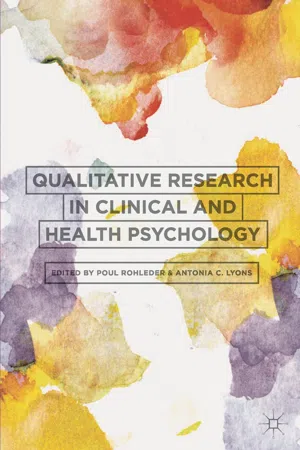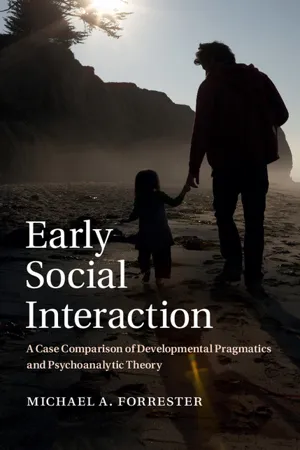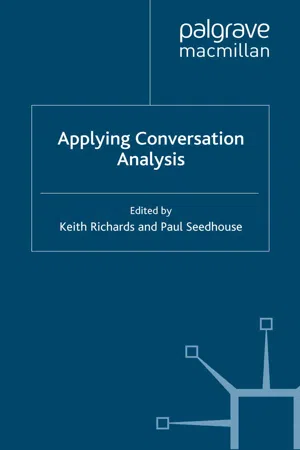Languages & Linguistics
Conversation Analysis
Conversation Analysis is a research method used to study the structure and organization of human interaction through the analysis of recorded conversations. It focuses on the detailed examination of how people use language in social interactions, including turn-taking, repair, and sequence organization. This approach provides insights into the underlying rules and patterns that govern communication in everyday life.
Written by Perlego with AI-assistance
Related key terms
1 of 5
12 Key excerpts on "Conversation Analysis"
- eBook - ePub
- Annette M. B. de Groot, Peter Hagoort, Annette M. B. de Groot, Peter Hagoort(Authors)
- 2017(Publication Date)
- Wiley-Blackwell(Publisher)
8 Conversation AnalysisElliott M. Hoey and Kobin H. KendrickAbstract
Conversation Analysis (CA) is an inductive, micro-analytic, and predominantly qualitative method for studying human social interactions. This chapter describes and illustrates the basic methods of CA. We first situate the method by describing its sociological foundations, key areas of analysis, and particular approach in using naturally occurring data. The bulk of the chapter is devoted to practical explanations of the typical conversation analytic process for collecting data and producing an analysis. We analyze a candidate interactional practice – the assessment-implicative interrogative – using real data extracts as a demonstration of the method, explicitly laying out the relevant questions and considerations for every stage of an analysis. The chapter concludes with some discussion of quantitative approaches to conversational interaction, and links between CA and psycholinguistic concerns.Introduction
The language sciences are undergoing an interactive turn, as researchers in social neuroscience (Schilbach et al., 2013), psycholinguistics (Pickering & Garrod, 2004; Levinson, 2016), and cognitive science (De Jaegher et al., 2010, 2016; Fusaroli et al., 2014) increasingly recognize interaction as the arena in which their diverse concerns converge. Underpinning this robust stream of interaction research are decades of cumulative discoveries from Conversation Analysis (CA) on the organization of interactive language use. This chapter explicates conversation analytic principles, findings, and methods.CA is an inductive, micro‐analytic, and predominantly qualitative method for studying language as it is used in social interaction. It differs most distinctly from other methods in this handbook in its use of field recordings of naturally occurring conversation; its focus on language as a resource for social action; and its procedure of basing analyses on the details of participants’ own behavior. As we will see, the method consists in the collection and curation of instances of an interactional phenomenon, the case‐by‐case analysis of that phenomenon, and the production of a formal account of its operation. The CA approach typically resonates with those who are interested in the specifics of human social conduct and committed to naturalistic observation. It offers researchers a well‐developed descriptive apparatus for investigating conversational interaction and a rigorously empirical procedure for supporting analyses. - John Hellermann(Author)
- 2008(Publication Date)
- Multilingual Matters(Publisher)
Conversation Analysis, Language Learning and Membership To recap: Research from an ethnomethological CA perspective empha-sizes the local co-construction of order and sense making through talk in social interaction. Our understanding of this order-making process is uncovered through the detailed analyses of the sequences of turns at talk. Through such detailed analyses, researchers attempt to show how the participants in the interaction orient to or interpret, moment-by-moment, the meaning of talk in social interaction. Through the examination of large databases of audio or video recordings and collections of similar action types, this method looks for recurring ways that these actions are accom-plished through participants’ co-constructed language practices. Since its inception, CA research has uncovered orderly practices, recur-ring pan-contextual methods that participants use to accomplish social action in mundane interaction such as opening and closing conversations, telling stories and doing repair. More recently, research from a CA perspective has begun to uncover interesting findings on the similar and different methods used by language learners in interaction with first-language speakers (Brouwer & Wagner, 2004; Hosoda, 2001; Kasper, 2004; Wong, 2000). While CA research has focused on understanding the ‘con-text-sensitive’ methods involved in co-constructing classroom interaction in general (Ford, 1999; Hellermann, 2005a; Koole, 2003; Lee, 2004; Lerner, 1995; Macbeth, 1990, 1994, 2000, 2004; McHoul, 1978; Mehan, 1979) recent research using CA has started to explore how interaction in the language classroom and how language teaching and learning is accomplished Conversation Analysis 37 (He, 2004; Hellermann, 2005b, 2006, 2007; Markee, 2000, 2005; Mori, 2002, 2004; Seedhouse, 1997, 1999, 2004).- eBook - PDF
Applied Conversation Analysis
Intervention and Change in Institutional Talk
- C. Antaki(Author)
- 2011(Publication Date)
- Palgrave Macmillan(Publisher)
I shall say something about each of these in this chapter, but it is the last, most interventionist, of these senses that this book as a whole is concerned. Conversation Analysis Before I describe those senses of ‘application’ in more detail, a capsule account of Conversation Analysis (CA) is in order. CA is the close 2 Applied Conversation Analysis examination of language in interaction. It answers these concrete questions: How do you and I bring off the business we transact with each other? How do I design my turns at talk to perform some action, and to make your next turn and next action fit a certain range of possible shapes? How, in short, does any pair or group of people use language to conjure up the social world of which they’re a part? By asking those kinds of question about people’s everyday methods for conducting their lives – as opposed to theorising more abstractly about soci- ety in general, or using summary categorising of what went on in it – Harvey Sacks and a small band of colleagues started a revolution in sociology in the 1960s. 1 The questions could only begin to be answered by recording human conduct and replaying it under inspection. Repeated playing of a recording of a given social scene had the same effect as Eadweard Muybridge’s slow- motion photographs had on the science of movement: to reveal a level of subtle organisation that demanded a new set of concepts, and a new vocabulary to express them in. - eBook - ePub
Research Methods in Clinical Linguistics and Phonetics
A Practical Guide
- Nicole Müller, Martin J. Ball, Nicole Müller, Martin J. Ball(Authors)
- 2013(Publication Date)
- Wiley-Blackwell(Publisher)
8 Conversation Analysis Applied to Disordered Speech and LanguageScott Barnes and Alison Ferguson8.1 Introduction
Conversation Analysis (CA) has enjoyed an increasingly prominent profile in research and clinical practice with communication disorders. Researchers have used conversation-analytic principles to examine interactions involving people with autism spectrum disorders, cerebral palsy, developmental language disorder, dementia, dysarthria, traumatic brain injury, and, especially, aphasia. CA takes as its primary object of study real-time instances of interaction between people conducting the activities of their everyday lives; be it ordinary, everyday talk (e.g. a family discussion over dinner), or talk in institutional contexts (e.g. a medical consultation). The activities of human societies are, by and large, conducted in and through “talk-in-interaction.” This term encompasses talk across contexts, and is also inclusive of non-vocal phenomena such as gaze, hand gestures, facial expressions, etc. (e.g. Schegloff, 2006).In this chapter we aim to provide the reader with an introduction to the main characteristics and methods of CA, and briefly outline how CA has been applied to communication disorders. Throughout this chapter, an extract from an interaction involving a woman with aphasia and dysarthria (V) and one of her friends (E) will be used to support our discussion of conversation-analytic practices and features of talk-in-interaction. Transcription conventions and the complete extract can be found in Appendices 8.A and 8.B respectively.8.2 Development and Principles
CA was developed as a method for doing sociology. Two significant influences in its formulation were Harold Garfinkel’s ethnomethodology (e.g. Heritage, 1984) and Erving Goffman’s work on the interaction order (e.g. Goffman, 1983). The founder of CA, Harvey Sacks, drew on their ideas and interests and, with his colleagues (in particular, Emanuel Schegloff) and students (e.g. Gail Jefferson, Gene Lerner, Anita Pomerantz), began investigating social interaction in novel ways. - eBook - PDF
Social Constructionism
Sources and Stirrings in Theory and Practice
- Andy Lock, Tom Strong(Authors)
- 2010(Publication Date)
- Cambridge University Press(Publisher)
Cultural discourses are seen to shape the micro-dynamics of social interaction in this ‘in Social Constructionism 280 and out of bounds’ way. But there is another approach to discourse analysis that looks at communicative interaction even more microscopically, as our means of reconciling being social with the personal: Conversation Analysis. Conversational Analysis The search for good problems by reference to known big issues will have large-scale, massive institutions as the apparatus by which order is generated and by a study of which order will be found. If, on the other hand, we figure or guess or decide that whatever humans do, they are just another animal after all, maybe more complicated than others but perhaps not noticeably so, then whatever humans do can be examined to discover some way they do it …That is, we may alternatively take it that there is order at all points. (Sacks, 1984: 22) Conversation Analysis (CA) takes Harold Garfinkel’s ( 1967) study of situated orders in a particular scientific direction that flourishes today. Initially the brain- child of Harvey Sacks ( 1995), CA follows Sacks’s attempt to ‘reverse engineer’ what he referred to as an ‘architecture or technology of intersubjectivity’. Such reverse engineering aims to show conversation as the means by which people sustain their relationships through how they handle particular shared problems in living. Sacks liked to show the particular conversational means people used to resolve such things as their membership in particular social groups, or how they brought a conversational topic to a close, or how they produced and handled lying. For him, these were ways of doing talk, and he referred to these ways in some- times off-putting mechanistic and technological language, as ‘devices’ for human communicative accomplishments. - eBook - PDF
- Ruth Wodak, Barbara Johnstone, Paul E Kerswill, Ruth Wodak, Barbara Johnstone, Paul E Kerswill(Authors)
- 2010(Publication Date)
- SAGE Publications Ltd(Publisher)
Unlike CA, SFL has had the added challenge of developing outside the USA during a period when US scholarship has tended to dominate the world. In Section 26.4 we outline some analytical techniques for describing conversation, drawn from aspects of these three different approaches. Conversation Analysis: a sociological approach to the analysis of conversation Background to development of Conversation Analysis Conversational analysis was stimulated by the sociological initiatives of Garfinkel (1967) 3 and Goffman (e.g. 1981), and developed into a distinc-tive field of enquiry by Sacks (e.g. Sacks, 1972a, 1972b, 1974, 1978, 1992). Like Garfinkel’s ethnomethodology, it was developed partly as reaction against the mainstream macro sociology that was current at the time; and CA researchers have been very careful to work only with catego-ries that emerge from the study of conversation and which interactants can be shown to orient towards. Sacks also worked in collaboration with Schegloff and Jefferson to develop this field of sociological enquiry further (Schegloff and Sacks, 1973, Jefferson, Sacks and Schegloff, 1987; Schegloff, 2006; Sacks, Schegloff and Jefferson, 1974). More recently, there has been a good deal of work devoted to linking CA to features of grammar as interpreted by West-Coast Functionalists (see e.g. Ochs, Schegloff and Thompson, 1996), and on applications involving CA work (see e.g. Hutchby and Wooffitt, 1998: Part III; McHoul and Rapley, 2001). CA is a distinctive research paradigm located within the wider field of enquiry of ethnomethod-ology, the focus of which, according to Heritage (1989: 21), is: …the study of the common-sense reasoning skills and abilities through which the ordinary members of a culture produce and recognise intelligible courses of action. CA is based on the insight that it is in and through conversation that most of our routine everyday activities are accomplished. - eBook - PDF
- M. Placencia, Kenneth A. Loparo, Rosina Márquez Reiter(Authors)
- 2005(Publication Date)
- Palgrave Macmillan(Publisher)
3 Conversation Analysis: Examining stretches of talk 3.0 Introduction In this chapter we look at the approach to the examination of conver- sation or stretches of talk advocated by conversation analysts, aspects of which have been highly influential in sociopragmatics. We refer here to 'ethnomethodological' Conversation Analysis or CA, as it is commonly labelled, rather than to linguistic or other approaches to the study of conversation (Markee, 2000). That is, we refer to the approach to the examination of 'talk-in-interaction' (Schegloff, 1982) which was developed in the 1960s by Harvey Sacks, together with Emanuel Schegloff and Gail Jefferson, and which has its roots in eth- nomethodology, a branch of sociology (see 3.1). Within this approach, talk-in-interaction is regarded as 'the primordial site of sociality' (Sche- gloff, 1986) in that 'the organization of persons dealing with one another in interaction is the vehicle through which those institutions ['(the) society' -the economy, the polity, the law, etc.] get their work done' (p. 112). The object of study for conversation analysts is, therefore, how talk is used in the construction of social (inter)action. For sociopragmaticists, the examination of language as a vehicle for social interaction is also central, although not from the same perspective (see 3.4). As we will see in section 3.5, most work carried out by Hispanists where CA analytical concepts are employed cannot be labelled ethnomethodological as their work reflects a different understanding of reality (see chapter 6). The goal of most Hispanists is to go beyond the description of structures of talk- in-interaction to the explanation of their use in relation to sociocultural factors, and to achieve this goal, they may make use of experimental rather than naturally occurring data. Over the past three decades, CA has expanded enormously and, as Firth (1996, p. 237) rightly claims, has emerged as 'one of the most 79 - Poul Rohleder, Antonia Lyons(Authors)
- 2017(Publication Date)
- Red Globe Press(Publisher)
Qualitative Methods: Exploring Social Worlds P ART III Conversation Analysis Chris Walton and W.M.L. Finlay This chapter is an introduction to Conversation Analysis (CA) as it can be applied to research in health and clinical settings. CA is an analytical method that allows the researcher to study in detail how people talk and interact with each other over a series of conversational turns. It has advantages over other observational methods in that it provides a much richer and more detailed analysis of social behaviour (and social order) than more traditional observa-tional methods. We start by describing the background of Conversation Analysis, then move on to describing some CA studies that address clinical issues. A brief descrip-tion of how an analysis might proceed follows, and we end by providing a short worked example from some of our own research. Readers wishing to pursue this approach are advised to supplement this chapter with the introduc-tory texts and resources listed at the end. Historical background No introduction to Conversation Analysis (CA) would be complete without mention of Harvey Sacks and the key role played by the lectures he gave between 1964 and 1972 at the University of California. Sacks died in a car acci-dent in 1975, but his lectures (edited by Gail Jefferson) were published posthu-mously (Sacks, 1992) and still form the central text for CA. They lay out what was then a new approach to understanding the coordination of everyday inter-action and are a touchstone for those now working within that approach (see Schegloff’s introduction to Sacks [1992] for a thorough account). As a sociologist, the work of Erving Goffman and Harold Garfinkel undoubtedly shaped Sacks’s approach. Sacks shared Goffman’s concern with everyday social interaction as a site of social order and with the procedures that give it, and the social selves that inhabit it, structure (what Goffman terms the interaction order ; Goffman, 1983).- eBook - PDF
- J.L. Mey(Author)
- 2009(Publication Date)
- Elsevier Science(Publisher)
Studies in the area of interaction and grammar explore the relationship between language structure, linguistic practices, and the organization of turn taking and of sequences in talk in interaction (Ochs et al ., 1996; Selting and Couper-Kuhlen, 2001; Ford et al ., 2002; Couper-Kuhlen and Ford, 2004). The work of Charles Goodwin has given a major impetus to the study of the multimodal and embodied character of the organization of human action in talk in interaction – not only the role of gaze, gesture, and 140 Conversation Analysis body positioning, but also the use of tools and other features of the setting (Goodwin, 2000; see also the workplace studies in Heath and Luff, 2000). Goodwin (2003) provides a collection of CA stud-ies of the ways in which people with one or another form of language impairment use various types of sequential and situational reasoning in ordinary communicative situations ( see Institutional Talk ; Family Speak ). Talk in institutional, professional, or work settings is also studied by describing how it is constrained or modified in comparison to conversational interaction (Drew and Heritage, 1992). The research in this area has frequently the shape of studying genres or activity types in a specific domain, e.g., the news interview (Clayman and Heritage, 2002), judicial interaction (Atkinson and Drew, 1979), emergency calls (Whalen and Zimmermann, 1990), meetings (Boden, 1994), telling good and bad news in clinical settings (Maynard, 2003), and gossip (Bergmann, 1993). The research here is sometimes called applied CA (see ten Have, 1999) ( see Institutional Talk ). Wootton (1997) is an example of a CA study in the area of early language acquisition. The study of for-eign language use in talk in interaction focuses on the organization of repair (see Schegloff, 2000b; Gardner and Wagner, 2004). - eBook - PDF
Early Social Interaction
A Case Comparison of Developmental Pragmatics and Psychoanalytic Theory
- Michael A. Forrester(Author)
- 2014(Publication Date)
- Cambridge University Press(Publisher)
Her detailed research on girls’ talk during street games showed the sophisticated manner in which children use the structures of talk to position themselves and oth- ers during the spontaneous construction of a localised social order (Goodwin, 2006). It is from this background that we find the emerging body of work that can now be described as child-focused Conversation Analysis (child-CA). The main thrust of the research centres not surprisingly on children learning how to talk with subsidiary work on CA&E-inflected studies of childhood. In much the same way that adult CA&E research although originating in sociology now crosses disciplinary boundaries, child-CA research can be found in develop- mental psychology and child language, linguistics and applied linguistics, soci- ology and the sociology of childhood and ethnography and social anthropology. While all such work employs CA methods, it is important to recognise that the research questions, and underlying theoretical leanings, can be quite diverse. The research designs are similarly varied encompassing single case-studies, longitudinal designs, cross-sectional comparisons, field studies, ethnographic descriptions and participant observation. What is consistent within the research field is a shared commitment to the analysis of children’s naturally occurring talk-in-interaction in situ. Another thing about the literature is the importance of distinguishing between a research focus which is primarily ‘developmentally informed’, where the methodology of CA&E is employed so as to map out a developmental profile of this or that particular skill, and a research agenda or interest where the focus is ‘ethnomethodologically informed’. - eBook - PDF
- Uta M. Quasthoff(Author)
- 2011(Publication Date)
- De Gruyter(Publisher)
Conclusion In this necessarily brief overview, I have tried to summarize some of the main theoretical and methodological precepts that are currently central to the practice of CA. The field resists easy summary because it is not premised on easily formulated theoretical generalizations, nor does its practice rest on methodologi-cal guidelines which can be packaged in the straightforward fashion that is often thought desirable in social science. Rather, the field consists of a growing set of self-embedding findings that constitute the theoretical background for new empirical initiatives. The latter, in turn, continue to provide new resources for the development of methodologically sound research practices. In this dynamic interplay between findings, theory and methodology lies the real strength of CA as a growing and diversifying empirical initiative in the study of oral communi-cation. References Atkinson, J. M. 1982 Understanding formality: notes on the categorisation and production of formal interaction, British Journal of Sociology 33: 86—117. Atkinson, J. M. 1984 Public speaking and audience responses: some techniques for inviting applause, in Atkinson, J. M. and Heritage, J. (ed.): Structures of Social Action: Studies in Conversation Analysis. Cambridge: Cambridge University Press, 370—409. Atkinson, J. M. 1992 Displaying neutrality: formal aspects of informal court proceedings, in Drew, P. and Heritage, J. (ed.): Talk at Work. Cambridge: Cambridge University Press, 199—211. Atkinson, J. M. and Drew. P. 1979 Order in Court: The Organisation of Verbal Interaction in Judicial Settings. London: Mac-millan. Atkinson, J. M. and Heritage, J. (Ed.) 1984 Structures of Social Action: Studies in Conversation Analysis. Cambridge: Cambridge Univer-sity Press. J. Heritage, Conversation Analysis 411 Bales, R. F. 1950 Interaction Process Analysis: A Method for the Study of Small Groups. - eBook - PDF
- K. Richards, P. Seedhouse, K. Richards, P. Seedhouse(Authors)
- 2016(Publication Date)
- Palgrave Macmillan(Publisher)
1 1 Introduction Keith Richards To every human problem there is a neat and easy solution – and it’s wrong. H. L. Mencken One of the strengths of Conversation Analysis (CA) as a research discipline is its capacity to direct researchers’ attention to apparently tiny features of interaction and explode their dimensions beyond all expectations, revealing delicacies of design and management that resist the assaults of clumsier instruments. The unwillingness of CA researchers to settle for easy solutions and their concern to elaborate the complexities of human action as revealed through talk have led to an impression in some quarters that the products of their investigations are too delicately wrought to bear the strains of application in the rough and tumble of practice. However, professionals in a range of disciplines from medicine to broadcasting have come to recognize the value of research that respects their peculiar achievements, and the field of Applied Linguistics (AL) has begun to acknowledge the contribution that CA can make to its programme. This book celebrates this important connection and anticipates some of its potential outcomes. A recognition of the possibilities inherent in exploring the applied dimension of CA gave rise to the seminar that was the genesis of many of the chapters in this book. It brought together conversation analysts from a range of academic and professional contexts and invited them to present examples of CA which arose from or pointed towards the possibility of professional intervention. However, no restrictions were placed on the form that this relationship might take, since the aim was to explore dimensions of application rather than to establish procedures for this. The resulting collection ranges from chapters that begin with practical K. Richards et al. (eds.), Applying Conversation Analysis © Palgrave Macmillan, a division of Macmillan Publishers Limited 2005
Index pages curate the most relevant extracts from our library of academic textbooks. They’ve been created using an in-house natural language model (NLM), each adding context and meaning to key research topics.
